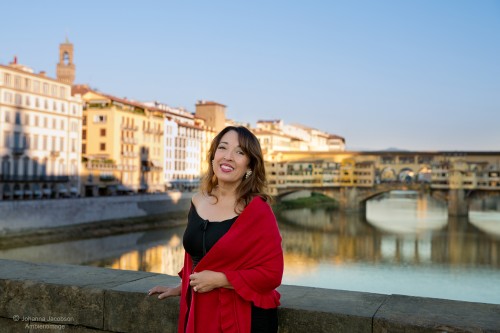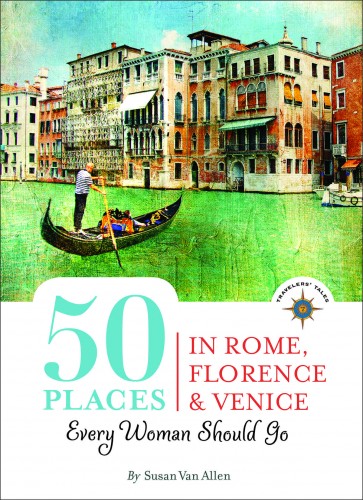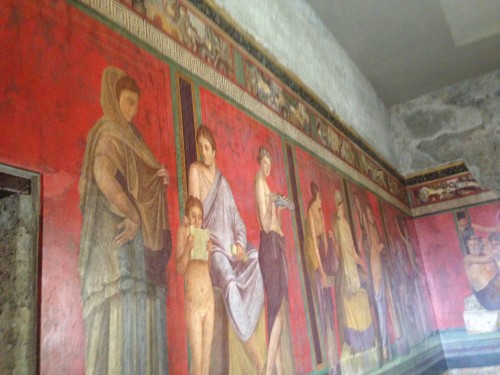Susan Van Allen probably never sleeps. She has written three interesting books that are must-reads especially women traveling to Italy. Her travel stories have been published in many media outlets, including National Public Radio, Town & Country, AFAR, Chicago Daily Herald, several Travelers Tales anthologies, and CNN.com. She makes presentations about Italian travel at such venues as The New York Times Travel Show and Museo Italo-Americano in San Francisco. She has a touring business, which introduces women to the joys of various regions of Italy every spring and fall. She’s also been an actor and a television script-writer.

Your book 100 Places in Italy Every Woman Should Go was very popular. Now you’ve published 50 Places in Rome, Florence, & Venice Every Woman Should Go. Did you have a different goal with the second book?
Instead of covering the entire country, the goal with 50 Places is to focus on the major cities—”Italy’s Big Three”. These three spots are often overwhelming, and many travelers arrive with “Must See” lists and then miss out on the fabulous unique spirits of each place. With so many guidebooks covering Rome, Florence, and Venice, 50 Places is for those seeking a more personal approach, as though they’re traveling with advice from a trusty girlfriend. For example, for the major sites, like the Uffizi in Florence, I give readers focus to see the art as glorifications of different aspects of femininity—from the sensual Goddess Venus to the compassionate Madonna—AND add in a Golden Day tip for the perfect place for dinner afterwards. I also steer readers to less crowded places in these popular cities, such as the stunning Palazzo Barberini in Rome, or to immersion experiences, such as maskmaking in Venice, that gives travelers the chance to have a hands-on experience of this beautiful tradition.
I believe you grew up summering at the Jersey Shore. What are some of the major misconceptions Italian-Americans have about Italy?
You’re right—I grew up on the Jersey shore, (West Long Branch, to be exact), surrounded by Italian Americans—including my mother. Her parents, my Nana and Papa, were part of the big wave of immigration from southern Italy in the early 20th century, and like the rest of these early immigrants they brought traditions from their homeland, that created an Italian-American culture. It’s radically different from Italian-Italian—so many Americans are shocked when they arrive in Italy and find it different from what they imagined.
A major misconception is around the food. American travelers are surprised to find no chicken parm on the menus, rarely spaghetti and meatballs served together as it is in America, and that the pizza that is most revered in Italy (from Naples) is not served in sliced pies, but in single servings of whole rounds, with soft centers, and eaten with a knife and fork—so delicious!

Another misconception is about Italian women. In the movies, we’ve seen all those Italian mammas with loads of children, stirring sauce at the stove. Sure, there are still Nonnas—grandmothers who spend days in the kitchen, but modern Italian women work, the birth rate is low—most have just one child, and husbands share in the cooking and child care.
Then there’s the endless tape about how dangerous the city of Naples is—and many travelers don’t even go to this marvelous city. An expression I grew up hearing was “Va’ a Napoli”—Go to Naples!—which meant: “Go to Hell!”. These days Naples is actually a flourishing city, with a vibrant historical center, amazing archaeological museum, fantastic food, and fabulous, welcoming natives—it’s a place to truly experience the vibrant soul of southern Italy.
It seems to me that your recent book Letters from Italy: Confessions, Adventures, and Advice is even more personal than the other two. What was the impetus for that book?
The impetus came from my beginnings as a writer, when I got the best advice: Write as if you’re writing a letter to a dear friend. I approach all my writing that way, including 100 Places and 50 Places—which are actually a mix of guidebook and travel essay. Letters from Italy brought me the satisfaction of sharing my experiences more completely, and includes essays I’ve written for National Public Radio and Travelers’ Tales anthologies. It’s a collection of nine stories from my travels over the years, ranging from adventures climbing to the top of the island of Stromboli’s volcano, to truffle hunting in Umbria, and the joys of flirting in Rome. I loved including practical advice at the end of each story for places to stay, eat, and shop, as whenever I read other travel stories I’m dying to know the practical details, so I can experience the same things the writer has, and come away with my own take on it.
You share your favorites in 50 Places in Rome, Florence, & Venice Every Woman Should Go. Have you ever been tempted to leave one out – a restaurant, a hotel, a small church or museum – because you don’t want it overrun with tourists? Were you tempted to keep it to yourself?
I’m not the type to keep Italian treasures to myself—I believe abundant Italy has enough for all of us, and am thrilled when I meet readers at my signings or travel shows who’ve taken my advice and discovered for themselves some of Italy’s less-trodden spots. One woman made a whole poster of the great time she had on the island of Ponza for me, another was ecstatic about visiting the Tarot Garden (packed with stunning mosaics) in a less explored province of Tuscany, and often when I’m back in Italy and re-visit my favorite shops, (like Marina e Susanna Sent in Venice—run by two sisters who make gorgeous contemporary glass tableware and jewelry), I’m happy to hear that women have come in and bought beautiful souvenirs, thanks to finding out about their place in my book.

You take women on small group tours, custom-designed to experience southern Italy and Florence. Describe one of your favorite experiences from one of these tours.
There are so many favorite experiences from these tours! I love to open the door for women to be in places I’ve fallen in love with and be by their side as they are seeing, tasting, and feeling the spirit of these places for the first time. And then there’s the great bonding that happens among women from such a variety of backgrounds, life experiences and ages. In one short week—from our welcome aperitivo to the farewell dinner—with so many adventures in between, I’m always thrilled to see how friendships are formed that last well beyond the Golden Week.
A favorite experience from a recent week in southern Italy was when we ended our tour of Pompeii in front of the recently restored mural in the Villa of Mysteries—a jaw-dropping painting cycle that shows a woman’s initiation into the Cult of Dionysus. As our guide took us through each panel, she became overwhelmed with the beauty of it and got teary-eyed—so did the women surrounding me—all of us taken in by the deep passion of this creation from thousands of years ago! It’s a memory-of-a-lifetime we will always treasure.
What, in your opinion, is the best advice to give travelers to Italy?
Go ahead and plan with the help of books and online resources, but always be sure to follow your personal desires, your mood day-by-day. This means slowing down, and leaving time for spontaneity. That’s when the Magic of Italian Travel takes over, you’re immersed in the sensual pleasures and wonderful surprises of the Bel Paese, and the trip becomes a soulful, transformational adventure beyond your imaginings. Buon Viaggio!
100 Places in Italy Every Woman Should Go at Amazon.com
50 Places in Rome, Florence and Venice Every Woman Should Go at Amazon.com
Letters from Italy: Confessions, Adventures, and Advice at Amazon.com
